#garter snakes
Text



I was so, so lucky to meet a very special trio of snakes for a class I'm taking on methods in field ecology. One of my two professors is a specialist in garter snakes and was kind enough to bring three different species in for us to compare in person and observe up close. The first was the gorgeous common garter snake, Thamnophis sirtalis, pictures above. She was so calm and well-mannered!
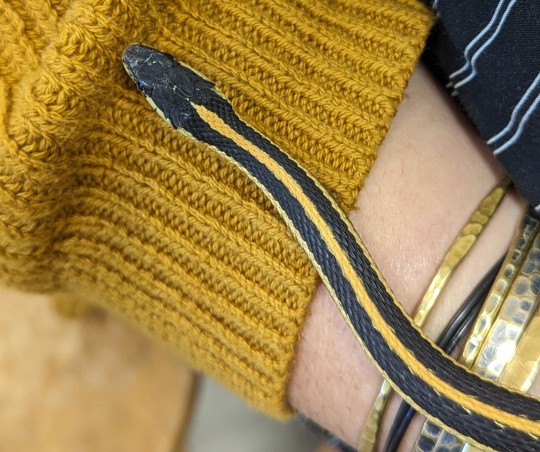


Next was this tiny (by comparison) T. elegans dude, a western garter snake, who was wary of the camera but very patient about being passed around by a group of excited college students. He matched my classmate's sweater perfectly!

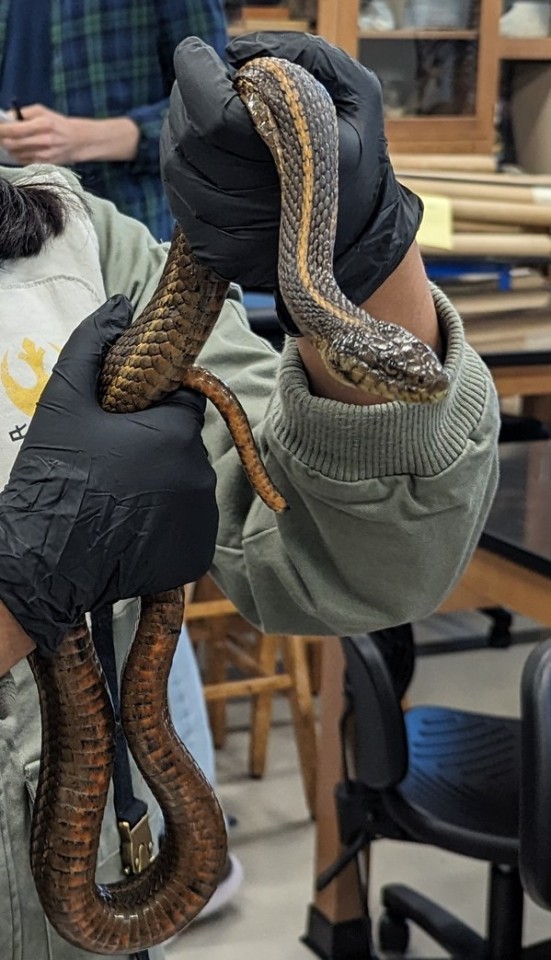

Finally, an endangered and incredibly precious T. gigas, the giant garter snake. She's about half of her maximum adult size, so a giant indeed! She musked and peed a bit but for the most part this gojira-faced beauty was pretty chill. We got to observe a full work-up for her including documenting records and microchipping.
She's one of the last of her species. Despite Herculean efforts by her protectors and conservation experts (mostly just one man and his dedicated team), this is a very difficult species to observe in the wild and their habitats are disappearing faster than their need for prioritization of protection in a given area can be assessed. These snakes rely on riparian habitat near rivers, which is also unfortunately a favorite for human development. At this time we don't know how exactly many giant garter snakes are left or whether their current populations are stable.
Today we got to visit their marshland habitat and watch these three go back to the place where they were caught. It was a huge honor and something I'll carry with me forever.
#snake#snakes#reptile#reptiles#reptiblr#garter snakes#garter snake#native species#we put that thing back where it came from or so help me#so help me!#science#ecology#endangered species#giant garter snake#western garter snake#common garter snake#when i got home i ate a salad so big that it made me sleepy
466 notes
·
View notes
Photo

Garter snakes coming out of hibernation and into a tens of thousands strong mating ball in southern Manitoba, Canada.
723 notes
·
View notes
Text

Nature's Marvels. Text by Lucy Berman. Illustrations by Roy Coombs. 1971.
Internet Archive
296 notes
·
View notes
Photo

An aquatic garter snake (Thamnophis atratus) in Santa Cruz, California, USA
by Ron Wolf
#aquatic garter snake#garter snakes#snakes#reptiles#Thamnophis atratus#thamnophis#colubridae#serpentes#squamata#reptilia#chordata#wildlife: california#wildlife: usa
167 notes
·
View notes
Text
#polls#poll#my polls#snakes#rattlesnake#rattlesnakes#garter snake#boa constrictor#garter snakes#boa constrictors#snake#reptile#reptiles#t
72 notes
·
View notes
Text
Well, I didn't expect to spend part of my evening going over to the home of a snake phobic person to gently remove and relocate two garter snakes from her garage to the other side of the property, but here we are. Mission accomplished.
#snakes#sneks#snekspertise#wildlife#nature#garter snakes#they're harmless and adorable#but if you have a phobia even the teeny ones are terrifying#my childhood spent catching garter snakes finally came in handy
54 notes
·
View notes
Photo


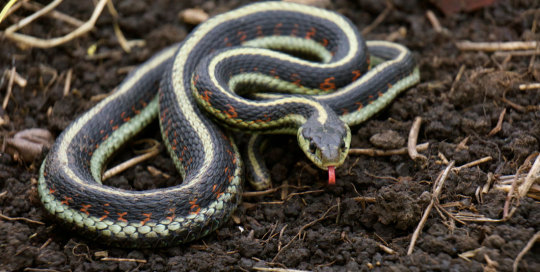
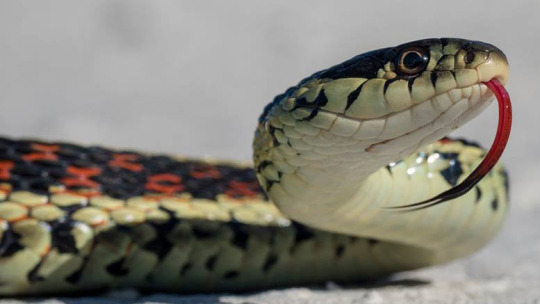
A Garden of Common Garter Snakes
Also known as the eastern garter snake, the common garter snake (Thamnophis sirtalis) is a species of snake found throughout North America. Populations can be found in almost any habitat and many are highly adapted; currently there are 13 recognised subspecies with distinct morphologies and behaviours. Most commonly garter snakes are found in forests, grasslands, wetlands, and rural and agricultural areas and are a popular sight for beginner herpetologists.
The appearance of the garter snake can vary greatly depending on area and subspecies. In general, T. sirtalis can be identified by a dark, usually black, brown, or olive body with three yellow, white, green, or blue stripes running down the back and sides, and a light underside. Some garter snakes will also sport red or dark brown spots, sometimes creating the appearance of being totally red. The best way to identify common garter snakes is by the scales around their mouths, which sport distinctive black stripes. Most individuals grow to be 40-60cm long and weigh about 150g, although some have been recorded at over 1m.
Although most consider the common garter snake to be non-venomous, they actually do produce a mild venom. This is most useful when hunting, as T. sirtalis feeds on a variety amphibians and small mammals. In addition to their venom, some populations have also developed a resistance to a toxic chemical called tetrodotoxin which is produced by a common prey animal the rough-skinned newt (Taricha granulosa). This adaptation has pitted the two species against each other in an evolutionary arms race, where the rough-skinned newt grows more toxic and the common garter snake becomes ever more resistant. In addition to these hunting measures, T. sirtalis will spray a foul-smelling fluid when threatened by predators such as hawks, snapping turtles, bullfrogs, large fish, and predatory mammals.
Like most snakes, T. sirtalis is active during the day. As ectotherms they rely on the weather to regulate their internal temperatures, so they are most often seen in the warmer spring and summer months. In their southern range the common garter snake is active year-round, and in colder areas they hibernate from October to March. Males emerge from hibernation first and form large ‘mating balls’ around emerging females, consisting of up to 20 individuals wrapping around each other in an attempt to reach the female. This allows the female to warm up faster and be ready to mate. Some tricky males will emit the same pheromones as females when emerging in order to recieve the same treatment; in this way they too are able to warm up more quickly and can reach ready females faster than their competitors. Females are oviviparous, meaning they develop eggs inside the body. After a gestation period of 2-3 months, up to 40 young are born live. They become sexually mature at about 2 years old and can live up to 6 years in the wild.
Conservation status: Because of their wide range and large population, the common garter snake is rated Least Concern by the IUCN. One subspecies, the San Fransisco garter snake (Thamnophis sirtalis tetrataenia), is considered endangered due to habitat loss and water pollution, which seriously impacts the availability of prey.
Photos
Mark Kluge (via iNaturalist)
Heidi Rockney
Kevin Urbanek
Jackson Shedd
#common garter snake#Squamata#colubridae#garter snakes#snakes#reptiles#deciduous forests#deciduous forest reptiles#grasslands#grassland reptiles#wetlands#wetland reptiles#urban fauna#urban reptiles#generalist fauna#generalist reptiles#north america#animal facts#biology#zoology
223 notes
·
View notes
Text


garter snake enclosure by misterfall
62 notes
·
View notes
Photo
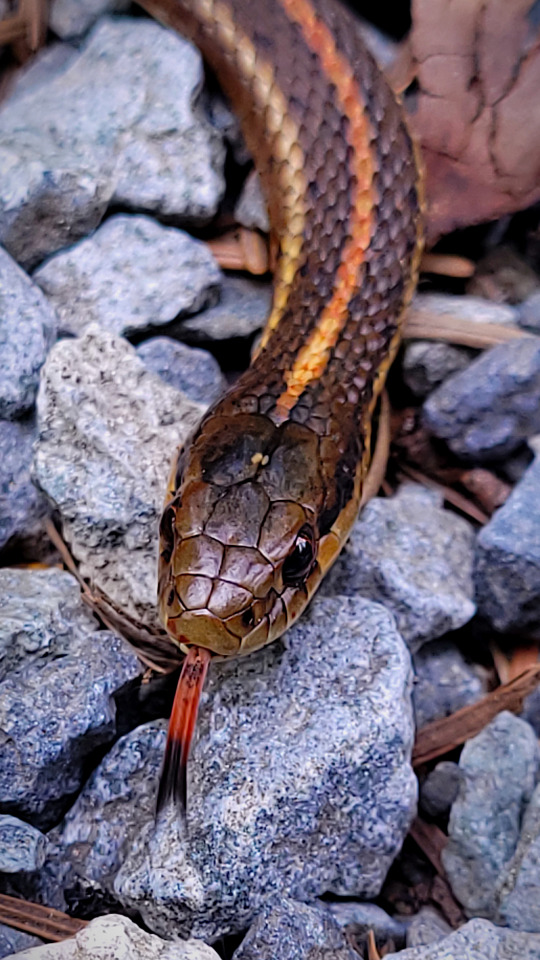
Northwestern Garter Snake
Thamnophis ordinoides
Western Washington, May 20 2022
Mary Howerton (shop)
#snake#snakes#garter snake#northwestern garter snake#thamnophis#thamnophis ordinoides#herpetology#animals#reptiles#wildlife#garter snakes#original photography#photographers on tumblr#lensblr#animalcore#pnw wildlife
93 notes
·
View notes
Text
Are there any garter snake experts here on Tumblr?
We have a couple of MASSIVE garter snakes in our yard. Biggest I've ever seen. I love having them, however, they find the top of the compost pile (right under the tarp) to be a prime location. We have to chase them away when we want to turn the compost.
Today there was a huge one curled up on top of a slightly smaller one. The smaller one was duller in color and had blue eyes so I'm assuming it's time to shed.
Was the big guy protecting the little guy? Do mates stay together for a bit? Or were they just curled up for warmth?
Anyway. Snakes are cool. Would love to learn more about garter snakes.
7 notes
·
View notes
Note
Absolutely obsessed with same sex relationships in animals, I’ve seen it most often in birds but *never* in reptiles!! Could you talk more about this?
Absolutely!
So, same-sex relationships can be a little hard to pin down in snakes because they're not really social animals. But we do have definitive evidence that some snakes engage in same-sex courting and mating behaviors! A few species of rattlesnakes and gopher snakes are especially known for this. Important to note here: absence of evidence is not evidence of absence, it's likely that many other snake species engage in same-sex courting and mating behaviors, but they're hard to observe in snakes who are less social and for whom these behaviors take like five minutes total.
But garter snakes are the standout here! They're easily one of the most social snake species out there, and are unique in that they will form "friend groups" of snakes they like to hang out with. And we can observe that some snakes prefer the company of the same sex, and some snakes exclusively court and mate with the same sex!
Because garter snakes can form these complex social relationships, where they actively choose to hang out with friends and pick the snakes they want to spend time with, we can also observe the thought they put into choosing the snakes they court! We've been able to see garters who consistently choose to court the same sex exclusively, and some who don't seem to mind the sex of their partner too much!
Garter snake social behavior is so interesting, and it tells us one thing pretty clearly: they're more than capable of putting thought into which snakes they partner with! It's a strong indicator that same-sex courting behaviors aren't at all uncommon in the snake world.

768 notes
·
View notes
Text
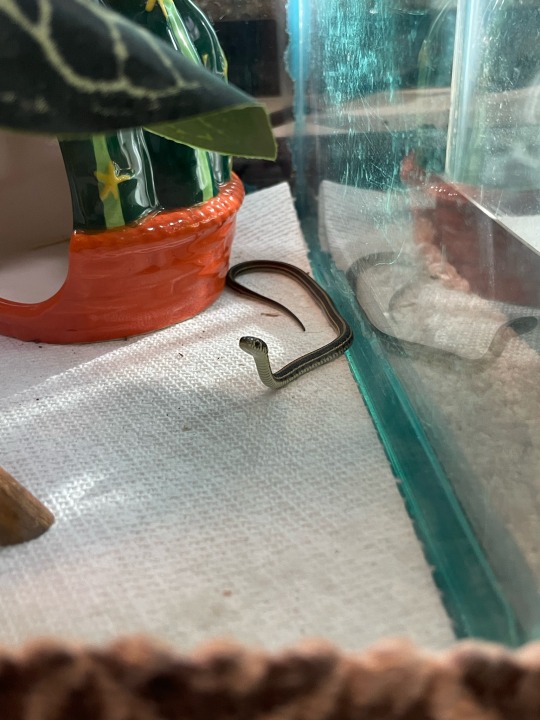
periscope animal
5 notes
·
View notes
Video
Short but sweet little video I captured earlier today of the garter snakes living in our rock wall. I saw the three males sunning themselves on the stones but couldn’t find the female (she probably wanted a break from their constant coiling around her)
Here’s some other shots I got of these little guys 🐍
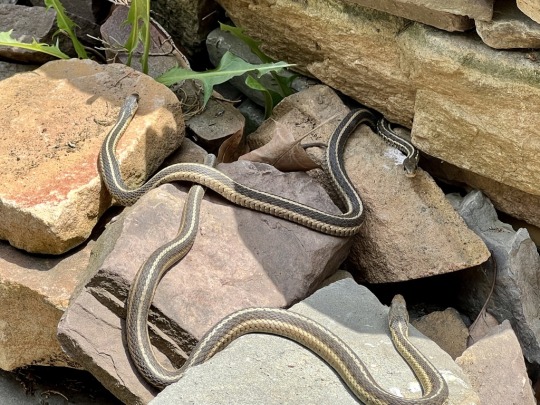
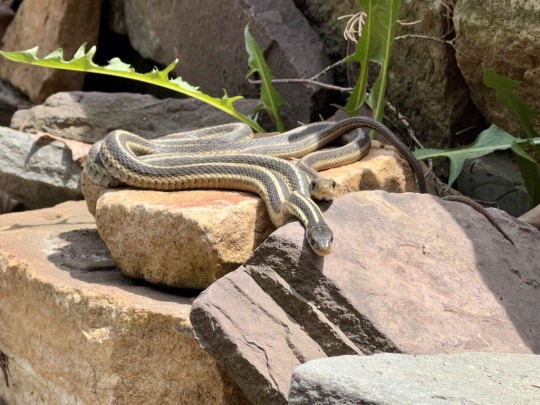

#garter snakes#snakes#reptiles#my photos#photography#my videos#they are just the most precious things <3
39 notes
·
View notes
Text

Ranger Rick's Nature Magazine; January 1967 edition. Illustration by Bob Hines.
Internet Archive
179 notes
·
View notes
Photo

A western terrestrial garter snake (Thamnophis elegans) in Yosemite National Park, California
by Ron Wolf
#western terrestrial garter snake#garter snakes#snakes#reptiles#thamnophis elegans#thamnophis#colubridae#serpentes#squamata#reptilia#chordata#wildlife: california#wildlife: usa
58 notes
·
View notes
Text
Source: @wildgreenmemes
#garter snakes#newts#video#I SEND MY PLAGUE I SEND MY SCOURGE#music in that movie went way too hard#also tho this is hilariously accurate#ecology
26 notes
·
View notes